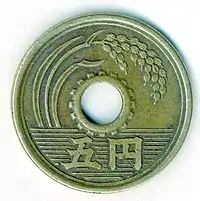1 yen coin
The 1-yen coin (一円硬貨, Ichi-en kōka) is the smallest denomination of the Japanese yen currency. The first Japanese one-yen coins were made of both silver and gold in the early 1870s. Issues facing the Japanese government at the time included wanting to adopt the gold standard, and competing against the Mexican dollar for use in foreign trade. The decision was made to use silver one yen coins exclusively outside of Japan for trade, while gold coins were minted and used in mainland Japan. Gold and silver coins were eventually allowed to co-circulate in mainland Japan from 1878 to 1897 when they were demonetized. Millions of former one yen silver coins were countermarked by the Japanese government for use outside of the mainland. Silver one yen coins continued to be minted until 1914 for backing up currency.
Japan | |
| Value | 1 Japanese yen |
|---|---|
| Mass | 1 g |
| Diameter | 20 mm |
| Thickness | 1.5 mm |
| Edge | Smooth |
| Composition | 100% Al (Current) |
| Years of minting | 1871–present |
| Obverse | |
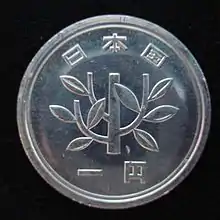 | |
| Design | Young tree with the words "State of Japan" above, and "1 Yen" below. |
| Design date | 1955 |
| Reverse | |
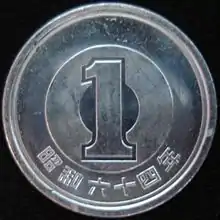 | |
| Design | "1" in a circle with year of issue in kanji Showa era year 64 (1989) |
| Design date | 1955 |
One yen coins were not made again until after World War II in the late 1940s. These were made up of a brass alloy and were only minted for three years. The current one yen coin dates to 1955, is made up of pure aluminium, and has a young tree design which has been used since. In the early 2010s increasing usage of electronic money led to a lack of demand, and production of the coin was confined to mint sets until 2014. Regular production only lasted until 2016, when new one yen coins were again confined only to mint sets. Like with the U.S. penny, the Japan Mint has minted one-yen coins at a loss due to the rising cost of the base metal used in the coins.
History
Early yen (1870–1914)
The first Japanese one-yen coins were minted between 1871 and 1872 using both silver and gold alloys.[1][2] This came at a time when a new decimal system was put into place, and a modern mint was established at Osaka. The yen was officially adopted by the Meiji government in an act signed on June 27, 1871.[3] While silver one yen coins are dated 1870, mint records show they were minted between 1871 and 1872 at the San Francisco Mint. Meanwhile, the first gold one yen coins dated 1871 were not minted until 1872 at the newly formed Osaka mint.[2] No silver one yen coins were struck in 1873 as the year was devoted to turning out gold pieces domestically.[4] The exclusive minting of gold coins during this time was reflective of the Japanese government's wish to switch to the gold standard in order to keep up with countries in North America and Europe.[5] The Japanese government eventually came to the conclusion that issuing silver one yen coins alongside standard gold coins was in the best interest of foreign trade. Silver one yen coinage was resumed in 1874 for use outside of Japan to compete with the silver Mexican dollar.[6]
Japan ultimately went with a bimetallic standard in 1878, which gave the one yen silver coin legal tender status throughout the country.[5][7] Silver one yen coins continued to be minted every year afterwards until 1897. Large amounts of coins were struck between 1878 and 1897 as the value of silver declined, which increased their demand. The fluctuations over the price of silver eventually made trade with Europe and the United States unreliable.[7] Japan officially switched to the gold standard on October 1, 1897 and all of the silver one yen coins were demonetized. Leeway time was granted until July 31, 1898 for those wanting to trade the coins for gold.[8] Many former one yen silver coins were then melted down to provide bullion for subsidiary coins. Others were countermarked "Gin" for use in Japanese-occupied Taiwan, Korea, and Lüshunkou.[9][10] Silver one yen coins were not stuck again until 1901 when they served as a reserve fund for "Bank of Formosa" notes.[11] This practice ended in 1904 due to the fluctuations in price between silver and gold.[12] The production of silver one yen coins eventually ended in 1914 during the 3rd year of Emperor Taishō's reign.
Modern yen (1948–)
Japanese coinage was reformed in 1948 with the issue of a brass one-yen coin. 451,170,000 coins were minted until production stopped in 1950.[13] The obverse of these brass coins features a numeral "1" with "State of Japan" above, and the date below, while the reverse reads "One Yen" with a floral pattern below it.[13] The current aluminium coin was first introduced in 1955 with a floral design. The obverse has a young tree, intended to symbolize the healthy growth of Japan. The reverse side of the coin has a figure "1" in a circle that represents one yen; below the digit is the year of issue which is written in kanji.[14] The one yen coin remains the oldest modern denomination coin with an unchanged design; throughout its minting history the coin was fully halted only once[lower-alpha 1] in 1968 due to excessive production.[15][14][16] In 1989 a national consumption tax (set at 3%) was put into place resulting in many prices that were not multiples of 5 or 10 yen, causing the Japan Mint to produce one yen coins in huge numbers.[16][17]
This consumption tax rate was raised in 1997 to 5%, reducing demand for the coin. By the turn of the century other factors such as rising metal costs and increasing usage of electronic money began to come into play. It was reported in 2003 that it cost 13 yen for the mint to produce a rolled plate[lower-alpha 2] for one yen coins. The rising price of aluminum had started to generate a commercial loss for the Japan Mint.[19] In 2009, unsuccessful measures that included raising money from the private sector were tried in order to lower the cost.[20] From 2011 to 2013 the Ministry of Finance stopped issuing new one yen coins for circulation. There was a small production run of 500,000 to 700,000 coins in mint sets for coin collectors.[17][21] Production resumed in 2014 when the consumption tax was raised again to 8%, causing sums to be less rounded.[22]
The cost of producing each one yen coin was reported to be 3 yen as early as 2015.[23] In the following year, more cashless transactions caused the ministry to stop issuing new one yen coins for circulation again.[17][21] It was reported in October 2017 though, that one yen coins remained popular in places like Osaka, where the coins are traditionally used for merchant transactions.[24] Despite their localized popularity, no coins have been made since 2016 apart from those in collectable mint sets.[22] The Japanese government has set a goal of increasing cashless transactions to 40% of all transactions by 2025.[17][22]
According to correspondent Leo Lewis of the Financial Times, the overall use of cash will not be "broken easily" in Japan. Lewis says that elderly Japanese people have not been eager for innovation, and conditions such as "low street crime, low interest rates and a reduced threshold on inheritance tax" remain in place that increase the appeal of carrying cash.[25] One-yen coins have also seen non monetary usage; since all 1-yen coins weigh just one gram, they are sometimes used as weights. If placed carefully on the surface of still water, 1-yen coins will not break surface tension and thus can also float.[25][26]
Composition
| Years | Material |
|---|---|
| 1871, 1874, 1876–1877, 1880, 1892 | 90% gold, 10% copper |
| 1870, 1874–1875, 1878–1914 | 90% silver, 10% copper |
| 1948–1950 | Brass |
| 1955–present | 100% aluminium |
Circulation figures
Meiji
The following are circulation figures for the coins minted between the 3rd and the 45th and last year of Emperor Meiji's reign. Coins for this period all begin with the Japanese symbol 明治 (Meiji). One yen trade dollars, minor varieties, and patterns are not included here. Countermarked yen ("Gin") are included in the original mintage totals.
- Inscriptions on Japanese coins from this period are read clockwise from right to left:
"Year" ← Number representing year of reign ← Emperor's name (e.g. 年 ← 五十三 ← 治明)
Gold
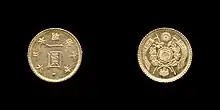
(one design used)
| Year of reign | Japanese date | Gregorian date | Mintage |
|---|---|---|---|
| 4th | 四 | 1871 | 1,841,288[27] |
| 7th | 七 | 1874 | 116,341[28] |
| 9th | 九 | 1876 | 138[28] |
| 10th | 十 | 1877 | 7,246[28] |
| 13th | 三十 | 1880 | 112[28] |
| 25th | 五十二 | 1892 | Not circulated[29] |
Silver
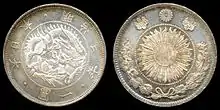
Design 1 - (1870)
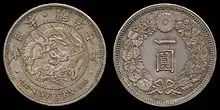
Design 2 - (1874–1914[lower-alpha 3])
| Year of reign | Japanese date | Gregorian date | Mintage |
|---|---|---|---|
| 3rd | 三 | 1870 (All types[lower-alpha 4] | 3,685,049[30] |
| 7th | 七 | 1874 | 942,006[31] |
| 8th | 八 | 1875 | 139,323[32] |
| 11th | 一十 | 1878 | 856,378[32] |
| 12th | 二十 | 1879 | 1,913,318[32] |
| 13th | 三十 | 1880 | 5,247,432[32] |
| 14th | 四十 | 1881 | 2,927,409[32] |
| 15th | 五十 | 1882 | 5,089,064[32] |
| 16th | 六十 | 1883 | 3,636,678[32] |
| 17th | 七十 | 1884 | 3,599,192[32] |
| 18th | 八十 | 1885 | 4,296,620[32] |
| 19th | 九十 | 1886 | 9,084,262[32] |
| 20th | 十二 | 1887 | 8,275,787[32] |
| 21st | 一十二 | 1888 | 9,477,414[33] |
| 22nd | 二十二 | 1889 | 9,295,348[33] |
| 23rd | 三十二 | 1890 | 7,292,877[33] |
| 24th | 四十二 | 1891 | 7,518,021[33] |
| 25th | 五十二 | 1892 (Early variety[lower-alpha 5]) | 11,187,613[33] |
| 25th | 五十二 | 1892 (Late variety[lower-alpha 6]) | |
| 26th | 六十二 | 1893 | 10,403,477[33] |
| 27th | 七十二 | 1894 | 22,118,416[33] |
| 28th | 八十二 | 1895 | 21,098,754[33] |
| 29th | 九十二 | 1896 | 11,363,949[33] |
| 30th | 十三 | 1897 | 2,448,694[33] |
| 34th | 四十三 | 1901 | 1,256,252[33] |
| 35th | 五十三 | 1902 | 668,782[33] |
| 36th | 六十三 | 1903 | 5,131,096[33] |
| 37th | 七十三 | 1904 | 6,970,843[33] |
| 38th | 八十三 | 1905 | 5,031,503[33] |
| 39th | 九十三 | 1906 | 3,471,297[33] |
| 41st | 一十四 | 1908 | 334,705[33] |
| 45th | 五十四 | 1912 | 5,000,000[33] |
Taishō
The following is a circulation figure for coins that were minted during the 3rd year of Taishō's reign. Coins from this period all begin with the Japanese symbol 大正 (Taishō). This was the final year one yen coins were minted in silver, and is a one year type.
- Inscriptions on Japanese coins from this period are read clockwise from right to left:
- "Year" ← Number representing year of reign ← Emperor's name (Ex: 年 ← 三十 ← 正大)
| Year of reign | Japanese date | Gregorian date | Mintage |
|---|---|---|---|
| 3rd | 三 | 1914 | 11,500,000[34] |
Shōwa
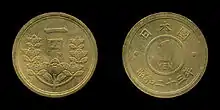
Design 1 (1948 - 1950)
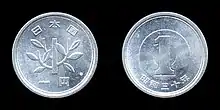
Design 2 (1955 - 1989)
The following are circulation dates which cover Emperor Showa's (Hirohito's) reign. The dates below correspond to the 23rd to the 64th (last) years of his reign. Inscriptions on coins for this period all begin with the kanji characters 昭和 (Shōwa).
These coins are read from left to right:
- Emperor's name → Number representing year of reign → "Year" (Ex: 昭和 → 六十二 → 年).
| Year of reign | Japanese date | Gregorian date | Mintage[15][lower-alpha 7] |
|---|---|---|---|
| 23rd | 二十三 | 1948 (Brass) | 451,170,000[35] |
| 24th | 二十四 | 1949 (Brass) | |
| 25th | 二十五 | 1950 (Brass) | |
| 30th | 三十 | 1955 | 381,700,000 |
| 31st | 三十一 | 1956 | 500,900,000 |
| 32nd | 三十二 | 1957 | 492,000,000 |
| 33rd | 三十三 | 1958 | 374,900,000 |
| 34th | 三十四 | 1959 | 208,600,000 |
| 35th | 三十五 | 1960 | 300,000,000 |
| 36th | 三十六 | 1961 | 432,400,000 |
| 37th | 三十七 | 1962 | 572,000,000 |
| 38th | 三十八 | 1963 | 788,700,000 |
| 39th | 三十九 | 1964 | 1,665,100,000 |
| 40th | 四十 | 1965 | 1,743,256,000 |
| 41st | 四十一 | 1966 | 807,344,000 |
| 42nd | 四十二 | 1967 | 220,600,000 |
| 44th | 四十四 | 1969 | 184,700,000 |
| 45th | 四十五 | 1970 | 556,400,000 |
| 46th | 四十六 | 1971 | 904,950,000 |
| 47th | 四十七 | 1972 | 1,274,950,000 |
| 48th | 四十八 | 1973 | 1,470,000,000 |
| 49th | 四十九 | 1974 | 1,750,000,000 |
| 50th | 五十 | 1975 | 1,656,150,000 |
| 51st | 五十一 | 1976 | 928,850,000 |
| 52nd | 五十二 | 1977 | 895,000,000 |
| 53rd | 五十三 | 1978 | 864,000,000 |
| 54th | 五十四 | 1979 | 1,015,000,000 |
| 55th | 五十五 | 1980 | 1,145,000,000 |
| 56th | 五十六 | 1981 | 1,206,000,000 |
| 57th | 五十七 | 1982 | 1,017,000,000 |
| 58th | 五十八 | 1983 | 1,086,000,000 |
| 59th | 五十九 | 1984 | 981,850,000 |
| 60th | 六十 | 1985 | 837,150,000 |
| 61st | 六十一 | 1986 | 417,960,000 |
| 62nd | 六十二 | 1987 | 955,775,000 |
| 63rd | 六十三 | 1988 | 1,269,042,000 |
| 64th | 六十四 | 1989 | 116,100,000 |
Heisei
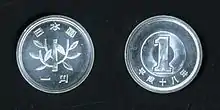
The following are circulation dates during the reign of Emperor Akihito (Heisei), who reigned from 1989 until his abdication in April 2019. The first year of his reign is marked with a 元 symbol on the coin as a one year type. Coins for this period all begin with the kanji characters 平成 (Heisei). One-yen coins dated between 2011 and 2013 were only released in mint sets. Mintage was briefly resumed in 2014 only for it to be halted again in 2016. No one yen coins were released for circulation for the remainder of Heisei's reign.
These coins are read with from left to right:
- Emperor's name → Number representing year of reign → "Year" (e.g. 平成 → 九 → 年).
| Year of reign | Japanese date | Gregorian date | Mintage[15][lower-alpha 7] |
|---|---|---|---|
| 1st | 元 | 1989 | 2,366,970,000 |
| 2nd | 二 | 1990 | 2,768,953,000 |
| 3rd | 三 | 1991 | 2,301,120,000 |
| 4th | 四 | 1992 | 1,299,130,000 |
| 5th | 五 | 1993 | 1,261,240,000 |
| 6th | 六 | 1994 | 1,040,767,000 |
| 7th | 七 | 1995 | 1,041,874,000 |
| 8th | 八 | 1996 | 942,213,000 |
| 9th | 九 | 1997 | 783,086,000 |
| 10th | 十 | 1998 | 452,612,000 |
| 11th | 十一 | 1999 | 67,120,000 |
| 12th | 十二 | 2000 | 12,026,000 |
| 13th | 十三 | 2001 | 8,024,000 |
| 14th | 十四 | 2002 | 9,667,000 |
| 15th | 十五 | 2003 | 117,406,000 |
| 16th | 十六 | 2004 | 52,903,000 |
| 17th | 十七 | 2005 | 30,029,000 |
| 18th | 十八 | 2006 | 129,594,000 |
| 19th | 十九 | 2007 | 223,904,000 |
| 20th | 二十 | 2008 | 134,811,000 |
| 21st | 二十一 | 2009 | 48,003,000 |
| 22nd | 二十二 | 2010 | 7,905,000 |
| 23rd | 二十三 | 2011 | 456,000[lower-alpha 8] |
| 24th | 二十四 | 2012 | 659,000[lower-alpha 8] |
| 25th | 二十五 | 2013 | 554,000[lower-alpha 8] |
| 26th | 二十六 | 2014 | 124,013,000 |
| 27th | 二十七 | 2015 | 82,004,000 |
| 28th | 二十八 | 2016 | 574,000[lower-alpha 8] |
| 29th | 二十九 | 2017 | 477,000[lower-alpha 8] |
| 30th | 三十 | 2018 | 440,000[lower-alpha 8] |
| 31st | 三十一 | 2019 | 566,000[lower-alpha 8] |
Reiwa
The following are circulation dates in the reign of the current Emperor. Naruhito acceded to the Chrysanthemum Throne on May 1, 2019 and he was formally enthroned on October 22, 2019. Coins for this period all begin with the kanji characters 令和 (Reiwa). The inaugural year coin (2019) was marked 元 (first) and debuted during the summer of that year.[36] One yen coins have not been minted for circulation since 2015. Those that are minted are intended for collectors who purchase them at a premium.
These coins are read from left to right:
- Emperor's name → Number representing year of reign → Year (e.g. 令和 → 元 → 年).
| Year of reign | Japanese date | Gregorian date | Mintage[15][lower-alpha 7] |
|---|---|---|---|
| 1st | 元 | 2019 | 502,000[lower-alpha 8] |
| 2nd | 二 | 2020 | TBD |
Notes
- None released in mint sets
- Metal is melted down into ingots that are then rolled into plates to the thickness of the desired coin, the blanks are then punched out of the plates.[18]
- The second and final silver coin design was also used during Taishō's reign.
- These coins were struck in 1871 using three different major varieties.
- Two different main varieties exist for coins dated 1892, both of which have to do with the dragon design present on the obverse side of the coin. The first is known as the "early variety" where the dragon's flame extends between the fourth and fifth spine.
- The second variety is known as the "late variety" where the flame overlaps the third spine of the dragon.
- Mintages on the Japan Mint website are in thousands
- Not circulated.[21]
References
- University of Wisconsin (1964). Japan Report. Consulate General of Japan. p. 10.
- Edouard Frossard (1878). The Coin Collector's Journal. 3. Scott and Company. p. 40.
- A. Piatt Andrew, Quarterly Journal of Economics, "The End of the Mexican Dollar", 18:3:321–356, 1904, p. 345
- Monetary System of Japan. Report and Accompanying Documents of the United States Monetary Commission. U.S. Government Printing Office. 1877. p. 297 & 298.
- "Collecting Japanese Silver Yen: The Dragon Yen 1870-1914". Antique Marks. Retrieved August 5, 2016.
- Alfred Stead (1904). Japan by the Japanese. W. Heinemann. p. 326.
- Gold Standard in International Trade. U.S. Government Printing Office. 1905. p. 485.
- New Coinage law of Japan. Sound Currency. Sound Currency Committee of the Reform Club. 1899. p. 28 & 29.
- Krause, Chester L. and Mishler, Clifford: 1996 Standard Catalog of World Coins (Iola, WI: Krause Publications, ISBN 0-87341-357-1), p. 1370.
- Colin R. Bruce, Marian Moe (1995). Collecting world coins: a full century of circulating issues. Krause Publications. p. 1949.
- Cornell University (1903). Appletons' Annual Cyclopaedia and Register of Important Events. D. Appleton & Company. p. 354.
- The Bank of Taiwan. Japan as it is. Kokusai Tsushin-Sha. 1915. p. 256.
- Chester L. Krause & Clifford Mishler. Collecting World Coins 10th edition. Krause Publications. p. 432.
- "1-yen Aluminum Coin". Japan Mint. Retrieved August 5, 2016.
- "年銘別貨幣製造枚数" (PDF) (in Japanese). Japan Mint. Retrieved April 4, 2020.
- "Japanese Coins". www.nippon.com. December 6, 2015. Retrieved August 2, 2016.
- JiJi (September 16, 2018). "Demand for lowly ¥1 coin sinks as consumers take to cashless transactions". Japan Times. Retrieved April 12, 2019.
- "Coin Production Process 1". Japan Mint. Retrieved April 12, 2019.
- "景気対策を目的とした政府貨幣増発の帰結" (PDF) (in Japanese). www.murc.jp. Archived from the original (PDF) on March 4, 2016. Retrieved August 1, 2016.
- "1円玉原価割れも 金属値上がりでおカネづくり一苦労" (in Japanese). www.nikkei.com. Retrieved August 1, 2016.
- Richard Giedroyc (October 29, 2018). "End of road for Japan's 1-yen coin". Numismatic News. Retrieved April 14, 2019.
- "E-Money Uptake Brings ¥1 Coin Production to Near Standstill". Nippon.com. February 1, 2019. Retrieved April 14, 2019.
- Lester Somera (December 8, 2015). "Understanding the Yen: Bills and Coins". Matcha magazine. Archived from the original on August 18, 2016. Retrieved August 5, 2016.
- Masahiro Hidaka (October 25, 2017). "Osaka's 1-Yen Sales Attract Shoppers But May Undercut Inflation". Bloomberg. Retrieved November 5, 2017.
- Leo Lewis (January 9, 2019). "Japan's cash addiction will not be easily broken". Financial Times. Retrieved April 14, 2019.
- "The Fate of the 1 Yen Coin – When will it lose its lustre in Japan?". www.stippy.com. June 24, 2012. Retrieved August 2, 2016.
- "Yr.4(1871)". Numismatic Guaranty Corporation. Retrieved March 25, 2019.
- "Japan Yen Y# 9a". Numismatic Guaranty Corporation. Retrieved March 25, 2019.
- "Yr.25(1892) None struck for circulation". Numismatic Guaranty Corporation. Retrieved June 3, 2019.
- "Yr.3(1870) Type I". Numismatic Guaranty Corporation. Retrieved March 25, 2019.
- "Yr.7(1874)". Numismatic Guaranty Corporation. Retrieved March 25, 2019.
- "Japan Yen Y# A25.2". Numismatic Guaranty Corporation. Retrieved March 25, 2019.
- "Japan Yen Y# A25.3". Numismatic Guaranty Corporation. Retrieved March 25, 2019.
- "Japan Yen Y# 38 Yr.3(1914)". Numismatic Guaranty Corporation. Retrieved March 25, 2019.
- "Japan Yen Y# 70 Yr.23(1948)". Numismatic Guaranty Corporation. Retrieved March 25, 2019.
- "Reiwa coins to debut summer 2019". mainichi.jp. Retrieved June 3, 2019.
